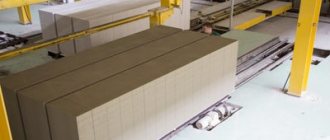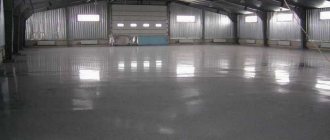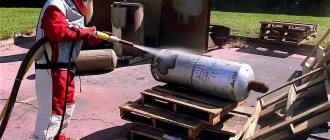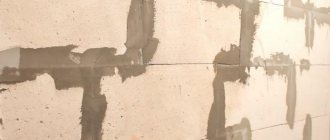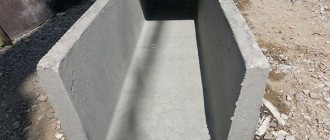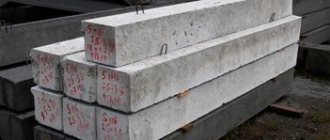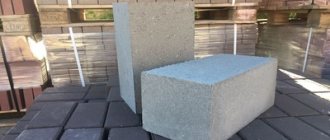Cellular concrete is increasingly used in the construction of residential and utility buildings.
Presented in concrete aerated blocks, they are easy to process, environmentally friendly and fire resistant. Aerated concrete blocks are considered lightweight, but durable and affordable varieties of artificial stone.
They are used not only for the construction of walls, but also as insulation.
The latter quality is considered especially in demand with a combined construction method, where a monolith is used for the front load-bearing walls and gas blocks for the internal second insulating layer.
Aerated concrete block - what is it?
Aerated concrete block is represented in the construction literature by different synonyms - aerated concrete, concrete aerated block.
Externally it has a general rectangular shape, but differs in :
- dimensions;
- purpose;
- geometric features:
- notches;
- grooves;
- hollowness.
For example, the photo below shows a standard view of a gas block according to the size range:
Aerated concrete is one of the main types of cellular concrete, which is created in the process of special chemical technology.
It consists in the formation of porous cells formed when the components included in the concrete composition are mixed, and the subsequent hardening of the block in a mold using an autoclave or non-autoclave.
In the artificially created stone, spherical pores with a diameter of 1 to 3 mm are evenly distributed. Thanks to the components and the voids formed, the material is cellular, but at the same time strong and hard.
Aerated concrete blocks have:
- uniform structure;
- grayish-white tint;
- flat surface;
- do not require additional grinding.
They can only be treated with special strengthening compounds, antifungal agents, priming components and sealants, for final finishing or when arranging a decorative surface.
The gas block has its own density mark (D), which must be indicated by the manufacturer on the packaging of the finished product.
According to brand characteristics and purpose, it is divided into:
- thermal insulation type (D300—D500);
- structural and thermal insulation type (D500-D900);
- structural type (D1000–D1200).
Rectangular blocks are universal and special. The various forms in which aerated concrete is produced are divided into :
- T-shaped (floor slabs);
- Arc-shaped (arched entrances);
- U-shaped (door, window openings).
Large rectangular aerated concrete blocks are available in various dimensions (mm):
- 400 x 400 (300) x 300;
- 600 x 300 x 200 (300);
- 600 x 400 x 300.
Other standards for the dimensions of gas blocks are presented as an example, in the photo below:
Aerated concrete blocks have different types, dimensions, shapes and markings, but despite this, the composition from which they are made is common (cement, quartz sand, gasifiers), with only slight differences due to incoming additives (ash, gypsum, lime ), enhancing the strength characteristics of the material.
Is there any harm to health?
Aerated concrete blocks are a material that is completely harmless to human health. Despite the fact that this material is artificial, it is made from natural components that are completely safe. The environmental friendliness is given by the natural components from which the blocks are made.
This material is actively used in modern construction; it has minor disadvantages. It can be safely used for buildings up to four floors high. The height of the building does not matter if partitions and load-bearing walls are made indoors.
The construction of buildings made of aerated concrete is associated with some peculiarities. Before starting work, you should carefully study not only the properties of aerated concrete, but also the technology for its installation. Aerated blocks are much easier to lay than bricks or cinder blocks.
Regulatory requirements for the material
Manufacturers of aerated concrete blocks are required to comply with the technologies established by current legislation.
Construction standards for the manufacture of gas blocks are based on the following legal framework:
- GOST 25485-89. Describes all the technical characteristics that must be present in cellular concrete.
- GOST 21520-89. Establishes technical conditions, especially paying attention to strength class B1.5.
- GOST 31359-2007. Draws attention to concretes made using an autoclave.
- GOST 31360-2007. Regulates technical conditions for cellular unreinforced concrete products.
- GOST 31357-2007. Description of the composition of the dry concrete mixture from which the aerated block will be made.
- GOST R 57334-2016/EN 771-4:2011. All technical conditions for cellular concrete blocks.
- GOST 12852.5-77 and GOST 12852.6-77. Requirements for the humidity of aerated blocks, including sorption.
- GOST 27005-86. Density control rules.
- SN 277-80. Instructions for the technology of manufacturing cellular concrete are provided.
There are also a number of documents on the basis of which compliance with technical conditions for materials is regulated and monitored. But the listed regulatory requirements are basic.
Reviews
This building material is truly considered popular. As follows from numerous reviews from owners, the gas block is easy to use, the price is very reasonable, and it fully justifies its declared qualities specified in the accompanying certificate. The service life of an aerated block is quite long; with proper attention, objects can be used for up to a hundred years.
The porous structure of the block makes it easy to process it with hand materials and hide wiring and other communication lines in the aerated block.
Having a machine for making blocks, it is possible to establish handicraft production of this stone right on the construction site. Naturally, one cannot expect full compliance with SNIP, but such material will be quite suitable for outbuildings.
Application of building wall blocks
Aerated concrete block can be used for the construction of walls, as well as for their insulation .
The presence of varieties by grade, determined by density D, allows you to install structures with or without reinforcement, depending on the purpose of the wall.
For example, after installing the structural blocks of the first row of a building, the second row is made using heat-insulating gas blocks.
Aerated concrete is widely used for the construction of residential, administrative, commercial and industrial buildings, even in harsh climates.
They are easy to work with, fast, and are suitable for various purposes , especially in combination with monolithic construction. But gas blocks are not suitable for buildings with a large number of floors. The maximum permissible number is no more than 3 floors.
Walls with aerated blocks are reliable, since the material can be used both to build an external wall and an internal one. The structure will be strong, stable, with good soundproofing and thermal insulation qualities.
Aerated concrete is also used as a restoration material for the walls of long-term buildings, as well as as a finishing material. Aerated blocks can be used to equip stairs, floor slabs and lintels.
Structural aerated concrete is suitable for the construction of basements and some types of foundations, and an expert inspection is required to determine the reliability and strength properties of the material.
Varieties
According to the general classification, in addition to their purpose (structural, heat-insulating and structural-heat-insulating blocks), aerated concrete products are also distinguished according to the following characteristics:
- According to hardening technology:
- autoclaved (prepared in autoclaves);
- non-autoclaved (dry in a natural environment);
- According to the presence of compound astringents, with the main component, more than 50%:
- limestone;
- Portland cement;
- slag;
- mixed (lime, slag, Portland cement);
- silica (natural and artificial).
Aerated concrete also differs in density grades D. Construction market standards are represented by 14 variants of medium-density aerated concrete from D200 to D1200. The most popular brands are D500-D700.
There are also primary aerated concrete blocks (made from the originally formed composition) and secondary products (processed product).
Detailed information about the types of gas block is in this article.
Parameters and characteristics
Basic examples of dimensions are indicated in the description, and as examples in the presented photos (see above). There are a huge number of different examples of blocks, depending on their purpose.
It is clear that if a gas block is used for decorative finishing, it will be much smaller than a regular one for the construction of a building frame. The photographs below show general examples of standard sizes:
Aerated concrete blocks are well processed, they can be :
- sawing with a jigsaw;
- drill;
- plan with special construction tools.
The material easily accepts driven nails and screws. It is not flammable, and its composition is represented by mineral components.
The durability of the material is due to the selected composition of the incoming mineral components. Aerated concrete has good air and vapor permeability, and retains heat well.
The properties of products also include density (kg/m³), which for autoclave blocks is D300-D700, and for non-autoclave blocks - D500-D900. The compressive strength of the products corresponds to B 1.5. According to the frost resistance grade, aerated concrete has an index of F15-F100 .
Whether an aerated concrete block shrinks depends entirely on the technology used to produce it. For dense autoclave grades, shrinkage is no more than 0.5 mm/m, for non-autoclave grades - 3 mm/m.
For more information about the technical features of a gas block, see the article at the link.
Features of working with gas block
The high thermal parameters of aerated concrete houses are associated not only with the low thermal conductivity of the blocks themselves, but also with the method of masonry. A thin seam of 1-3 mm, versus the standard 10-12 mm, reduces heat loss through cold bridges - the wall turns out to be almost uniform. Today there are two ways of laying walls.
- For glue - specialized ready-made mixtures for thin-stitch masonry are produced in bags, mixed according to the instructions using a construction mixer, and applied to the surface of the blocks with a special notched trowel. The cost of a bag of glue is more expensive than the cost of a bag of cement; due to the thickness of the seam, in the end the use of glue is not only more convenient, but also cheaper, and adhesion is much better.
- For polyurethane foam - one-component polyurethane foam adhesive in pressure cylinders, used not only for gas blocks, but also for warm ceramics. This is a specialized waterproof foam with a low coefficient of secondary expansion, usually produced by aerated concrete manufacturers, like adhesive mixtures. When laying on foam, there are no wet processes and the amount of heat loss through the wall is even less than when laying on glue, but the geometry of the blocks must be ideal. But in our reality, some companies, even using the autoclave method, manage to produce blocks with not the highest quality, and first of all this concerns dimensions and planes. If there is a “tolerance” of at least a couple of mm in the adhesive seam, it is basically impossible to “play” on the foam; under the weight of the block it spreads over the surface. Maybe that’s why laying on foam is much less common in our country, and the use of glue is ubiquitous.
When laying blocks, a standard set of tools is used.
- Trowel - for uniform application of glue on the surface, there is no particular point in making something homemade; there are a lot of budget options on sale for different block sizes.
- Saw for aerated concrete - blocks can be processed well with hand tools; a special saw is distinguished from a regular hacksaw by the large thickness of the blade and the shape of the teeth.
- Mallet - a rubber hammer is more convenient and safer to use for upsetting.
- Planer - for leveling the surface; many self-builders prefer homemade graters for the block. Experienced people recommend getting two – a large one, for rough leveling, and a small one, for finishing the plane.
- Bubble level - to control the geometry of the masonry. Some people prefer laser levels.
- Wall chaser – grooves are cut out in gas blocks for reinforcement and embedded parts; they can be made either with a manual wall chaser or with a milling cutter. They manage to work with an angle grinder, cutting “grooves” and gouging out the middle, or they automate the process.
Futu8FORUMHOUSE Member
You take 2 diamond disks and clamp them side by side, the resulting groove can accommodate the average VVGng 2x2.5 mm. If the grinder pin allows it, you clamp the discs through the washer; it would be nice to also have a toggle button to control the direction of rotation.
Plus, in addition to the main kit you will need a spatula, a brush for removing dust from blocks, a marking square and a “classic of the genre”, a marking cord-mooring.
Aerated block is considered an easy-to-work material, which is facilitated by its solid dimensions, ease of processing, and the availability of masonry on your own. Large-format masonry is simpler, since the walls need to be finished - even minimal ones will hide many errors, not to mention hanging facades or cladding. Difficulties arise due to the weight of the blocks; if you overdo it, you can really break your back, especially when working with one helmet. To make the work easier, our craftsmen assemble the cranes. A simpler option is a special belt, which ideally should be worn before, but in practice it also helps after, when the back has already suffered.
MichaelJacksonFORUMHOUSE Member
I sewed myself a belt from seat belts - puts it on quickly, takes it off quickly, you can wear it under a jacket or under a shirt. Already with a torn back, he moved nine tons of aerated concrete in it in one day without any problems. I recommend!
Selection rules
When choosing aerated blocks for construction, be sure to pay attention to :
- future load on the walls (preliminary calculations are carried out for this);
- dimensions of products (depending on the classification type);
- purpose (for lintels, thermal insulation, load-bearing frame);
- brand (all types of indicators presented by the manufacturer, but especially the density indicator D);
- packaging (must be undamaged, in cellophane wrapper, with instructions for use and an accompanying quality document).
Aerated concrete blocks greatly simplify any construction process and have a low cost for all their varieties.
With proper installation technology, aerated concrete materials can ensure proportionality and strength of the masonry.
The best block manufacturers and additional tips for choosing materials are here.
Conclusion
Like any wall material, aerated block has certain properties that must be taken into account both at the stage of choosing the material and during the construction process. It cannot be said that the gas block is the best, to each his own, but to say that it is the worst is at least unfair. The same glass can be half empty and half full, it all depends on the point of view.
On the topic, you can read about the construction and operation of houses made of aerated concrete, as well as how to cost-effectively decorate the façade with aerated concrete tiles. The video shows the filling of the armored belt.
Subscribe to our Telegram channelExclusive posts every week
Production technology
The product has the following composition:
cement of different brands (usually M300 and M500);- running water;
- quartz sand;
- gas formers (fine aluminum in the form of paste, suspension);
- additives (gypsum, ash or slag).
As a result of the chemical reaction of the mixed components, under the influence of gas-forming agents, the composition foams, due to the bubbles formed during the release of hydrogen, takes a given shape, and is left to harden.
It can be dried in an autoclave (hence the name of its variety) or in air (non-autoclave type). Then it is taken out of the mold and cut to the specified dimensions, or left in its original form. To increase strength, blocks can be treated with hot steam.
A non-autoclave gas block is cheaper than an autoclave one. At the same time, it does not lose its strength characteristics.
Read more about the production technology of aerated blocks here.
Compound
The recipe for gas block material is quite simple. It includes the following ingredients:
- cement composition;
- river sand;
- aluminum powder (used as a blowing agent);
- quicklime.
The feedstock may additionally include ash or gypsum.
Advantages and disadvantages
The advantages of aerated concrete include:
- light weight and convenient transportation, despite the voluminous dimensions;
- durability, good density and strength;
- high thermal insulation characteristics;
- low background radiation and environmentally friendly composition;
- good sound and noise insulation;
- high water-repellent properties and frost resistance;
- excellent fire safety (do not support fire);
- suitable for harsh climates;
- quick installation (high-speed);
- rarely forms cracks on walls;
- found in various markings;
- large selection of blocks due to size;
- promotes the creation of natural air circulation;
- versatility of use;
- comply with GOST standards;
- resistance to fungi and mold;
- low cost;
- You can build any structure with your own hands, without involving professionals.
Considered as disadvantages:
- the material is not suitable for the construction of buildings more than 3 floors;
- the appearance of cracks due to errors in the foundation;
- needs special deep impregnation when building basements or baths;
- requires the purchase of special fasteners for installation.
Aerated concrete material has more advantages than disadvantages - this explains its demand. The quality characteristics shown in the photo below are very much appreciated:
You can learn about the pros and cons, as well as what consumers and experts say about gas blocks in reviews from this article.
Photo
You can see what different types of gas blocks look like in the photo:
U-blocks
Aerated concrete with grooves
Straight blocks
